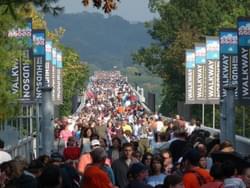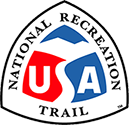




Walkway Over the Hudson opening celebration spanned the weekend of October 2-4, 2009. The noted historic structure also adds to the commemoration of the 400th anniversary of Henry Hudson’s exploration of the valley.


Designated in 2009
• View more details for this trail
in the NRT Database
• Learn about the NRT Program.
The “Walkway Over the Hudson” project on the Hudson River in New York has turned a historic railroad bridge into a scenic biking and pedestrian pathway.
The 120-year-old Poughkeepsie-Highland bridge had been unused and poorly maintained since a fire forced its closure in 1974. The new trail, which is scheduled to open October 2, will transform the railroad bridge into a linear park and trailway. It provides public access to the Hudson River's scenic landscape for pedestrians, hikers, joggers, bicyclists, and people with disabilities. The bridge also provides important connections to an extensive network of rail-trails, parks and communities on both sides of the river.
“The Hudson River Valley is one of America’s most scenic geographic corridors, and this project will allow thousands of people to enjoy its beauty,” Secretary Salazar said. “I encourage all New Yorkers and visitors to New York to hike or bike the bridge when the trail opens.”
The bridge is 6,768 feet long (over a mile and a quarter). The top of the bridge deck is 212 feet above the water. It was built soon after the Brooklyn Bridge, but the Poughkeepsie-Highland structure is both longer and higher above the water than the Brooklyn Bridge.
Walkway Over the Hudson, a local nonprofit organization, owns and manages the recreation conversion project. The New York Office of Parks, Recreation and Historic Preservation (New York State Parks) is the responsible state agency. A significant portion of the design and inspection costs were funded by the Dyson Foundation. Consulting services are being provided by the Bergmann Associates team. Upon completion of the project, New York State Parks will be responsibile for managing public use of the Walkway, including staffing, operating costs, and maintenance. Ownership of the bridge structure will be transferred to an appropriate state agency which will be responsible for maintaining the bridge deck, steel superstructure, piers and substructure.
According to the Dyson Foundation, "Members of Walkway Over the Hudson, a nonprofit group with a growing grassroots membership and a passionate leader named Fred Schaeffer, held fast to the dream that this landmark bridge should be preserved and turned into an elevated pedestrian and cycling park someday. They believed that its stunning views of the Hudson River Valley and its potential to connect rail trails and waterfront parks on both sides of the river would draw hundreds of thousands— that tourists and locals alike would flock to this great park in the sky in droves."
Fred Schaeffer, Chairman of the Walkway Over the Hudson, is an attorney in Poughkeepsie. He is also an enthusiastic bicyclist and photographer, and leads walking tours of historic towns in the area. See a photo of Fred and more about the bridge project in a Poughkeepsie Journal article by Christine Negroni.
The cost of constructing the Walkway project is estimated to be $38.8 million. The project is being funded through a mix of private and public funds. The costs, while enormous, was compared to the unattractive option of demolition, which had been estimated at more than $50 million.
An economic impact study of the trail project a range of about 267,000 visits each year, generating an impressive annual economic benefit of $21 million to the regional economy. In addition, it is expected the bridge will generate $1.3 million annually in new overall tax revenue to local, county and state governments.
Access will be provided on the west end of the bridge from Haviland Road in Highland, NY and the adjoining rail trail. On the east bank in Poughkeepsie, bridge access will be provided at Washington Street. In addition, work is being done to secure funds for an elevator to be located on the Poughkeepsie waterfront and near to the Poughkeepsie railroad station. The elevators will make the project ADA compliant and accessible by persons with disabilities. Both ends of the bridge will have designated handicapped parking.
Opening celebration October 2-4, 2009
The opening celebration included the "Walking on Air Procession," as the bridge became the stage for a performance created and put on by thousands of volunteers. Two processions started from opposite ends of the bridge, representing the east and west shores now joined by the Walkway, as well as the history of the Hudson River.
The procession included visuals drawn from three periods in the bridge’s history. The organizers of the celebration described how it would unfold:
"Act One, entitled Water, explores the early maritime history and unique tidal ecology of the Hudson. Act Two, Steam, celebrates the engineering marvel of Poughkeepsie Rail Bridge itself, and its role in the industrial age of coal and commerce. Act Three, Air, completes the upward progression and celebrates what the bridge has become, a breathtaking passage into thin air. We will harness wind-powered structures to catch the wind and mark the transformation of the bridge into a human-centered space, and our transcendence from the Coal Age to an imminent future of local, human-scaled power."
Concept and Design: Alex Kahn and Sophia Michahelles
Walkway Opening Celebration Director: Jeanne Fleming
Walkway Over the Hudson PO Box 889 Poughkeepsie, NY 12602 (845) 454-9649 [email protected] http://www.walkway.org